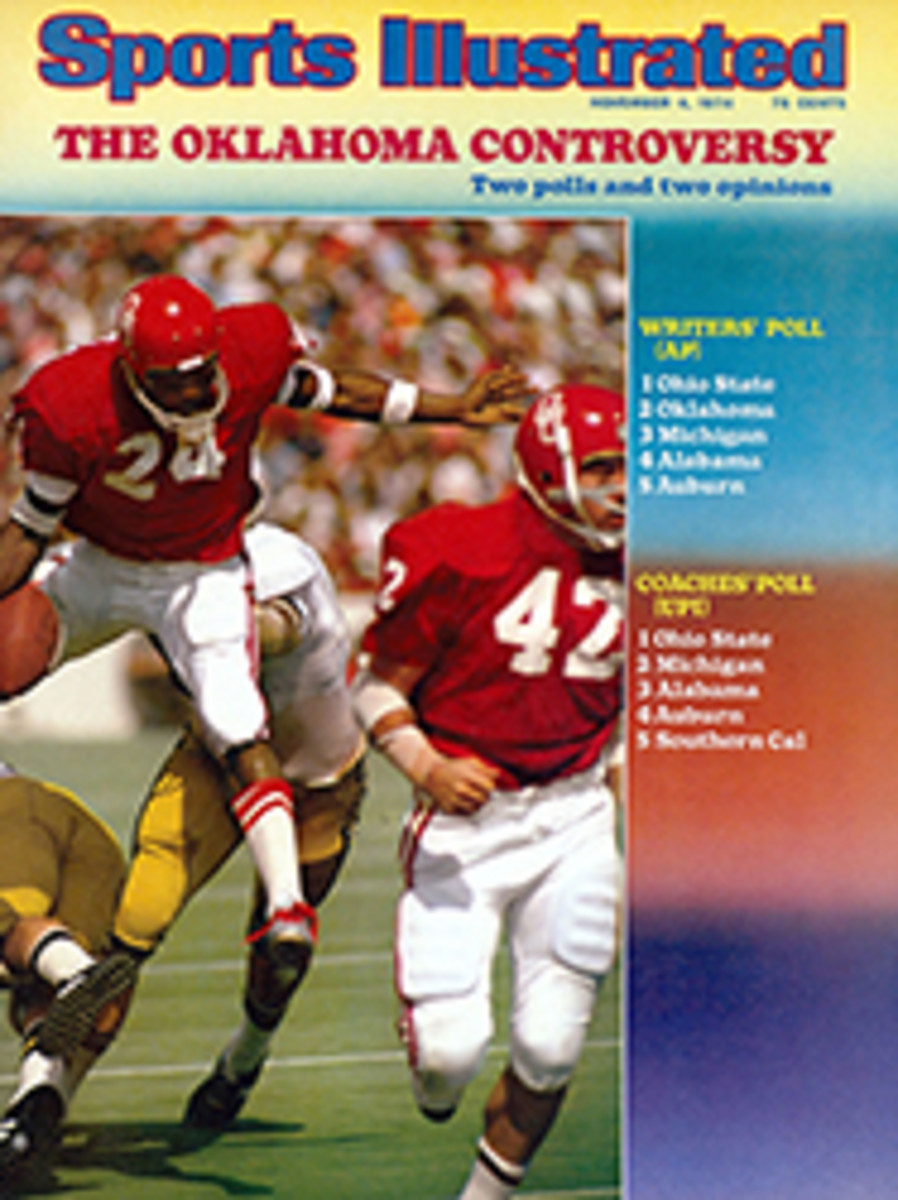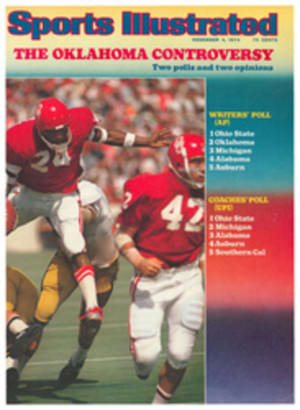
The Little Big Horn with pads
Grand Forks, N. Dak. is the kind of place where you feel comfortable in raveled grammar and a sloppy sweater. Even the scenery is predictable, reminiscent of vintage cartoon backgrounds in which the same tree reappears every few seconds. But for a few hours last Saturday, Grand Forks was the volatile center of its constellation, proving that a Big Game is a Big Game whether it is on artificial turf or just plain dirt.
North Dakota was playing South Dakota, and from the sound and the fury you might have suspected ole Jesse and the rest of the James gang had detoured through on the way home from the Great Northfield Minnesota raid. Every potato and sugar-beet farmer, every electioneering politician out to strip-mine a vote and every alumnus with an ego painted in his school colors had nestled into cozy Memorial Stadium to whoop, holler and revel in the catharsis.
South Dakota won the game 37-24 and with it the Sitting Bull Trophy, perhaps an inconsequential prize to the national press, but a garland of laurel to the participants.
Both the NCAA College Division schools are in the North Central Conference, an admittedly obscure although highly competitive amalgamation that has ushered its share of players into the professional ranks and justified the need for computer scouting. And the players, although generally smaller if not necessarily quicker than the behemoths laboring in better-known football boiler rooms, refuse to look wistfully at the contrails of major college football. "We played Minnesota this year and I thought North Dakota State hit harder," said Flanker Ron Gustafson of North Dakota's Sioux.
Unless you majored in geography, the Dakotas are a hard place to draw a bead on. Most Americans have heard of them and believe in their existence, but are content with secondhand accounts of this rigorous country and climate. And they are intimidating; by September the land turns gray and bleak and for much of the year the sun appears covered, as if with a lampshade. Consequently, it is startling to note the presence of 13 players from Florida on the South Dakota roster.
They were recruited through Bill O'Hara, a Miami teacher, and Joe Robbie, the owner of the Miami Dolphins and a South Dakota grad. Since the school does not pay to fly in recruits, most never see it until they enroll. Good thing. The first sleet fell on Oct. 6 this year. "I don't even know if they realize where they're going," says Joe Salem, the South Dakota coach. "But, you know, none of them leave."
Dwight Duncombe is one of those Floridians and the best player on the team. He is a split end but acts more like a Russian folk dancer; when he catches a touchdown pass he usually performs a victory cartwheel and back flip. His recruitment was typically bizarre. It seems another South Dakota player was working one summer as a skycap at the Miami airport, where he met a contemporary who said he was an out-of-work linebacker presently employed at an all-night grocery store. The ensuing conversation led the linebacker to Salem's office. He brought along a friend. The friend was Duncombe. But Duncombe's grades were too low for a scholarship, so Salem called the youngster's father for advice.
"Your father says for you to stay here," Salem told Duncombe.
"Oh, no," Duncombe said.
But he did and it turned out to be a happy marriage. Duncombe learned to wear heavy clothing, and going into the North Dakota game he had opportunity to perform his backflips 16 times this year. Against North Dakota he scored three times in the second half, although only two counted. A 67-yard punt return was called back because of a clipping penalty at the one-yard line.
South Dakota had won only nine games in six years prior to Salem's arrival in 1966, after a career as a third-string quarterback at the University of Minnesota. His first team's roster listed 29 players and he had practically no basic equipment. Salem bought a few barbells. Someone stole them. Still, by 1968, the team was 9-1.
Now there are plans for a $9 million Dakota Dome in Vermillion, S. Dak. that will seat 11,000 for indoor football. But for the most part the team still labors in a spare, pinched style. A ripped pair of football cleats can throw the coaches into a stew as they search for a replacement; shredded practice jerseys are meticulously taped back together; and the team had to endure a nine-hour bus ride on the trip to North Dakota.
Some coaches regard the Wishbone as last year's fad, like the Gatsby look or streaking, but Salem is sticking with it. The team lost its first five games after it was installed three years ago, but was 9-1 in 1972 and 8-3 last season and went to the College Division playoffs. This season a plethora of freshmen running backs fumbled 24 times in the first five games and the normally glib Salem, a man who wears a smile as naturally as the part in his hair, turned briefly dour. Then the ball handling improved, and with it his mood. So much so that the confident coach started six frosh against North Dakota.
Unlike George McGovern, Salem's team has had scant trouble getting votes in the polls. With a record of 6-1, South Dakota was ranked eighth in one, ninth in another before the North Dakota game. To stay there, and to remain undefeated in the conference, the Coyotes had to beat a team that had been its nemesis. In the last 14 games with North Dakota, South Dakota had won only twice.
In contrast to the cosmopolitan South Dakota squad, North Dakota's is mostly homegrown. One local product is Ron Gustafson. In 1973 he led the College Division in pass receptions with 67. This season Coach Jerry Olson shifted the emphasis to a running attack centered around Fullback Bill Deutsch, who gained 137 yards Saturday, and option Quarterback Brian Grover, but Gustafson still was second in conference scoring, thanks to three touchdowns in a game in which injuries forced him to play running back. He is rumored to be a certain top draft choice by the pros. "I'm not thinking about that," he says. "When you start looking ahead you get your head knocked off."
Besides having the hands of a juggler and the knack of catching a ball thrown into a crowded crosswalk, Gustafson also is adroit in the open field, the reason for the nickname of "Magic." He returned a kickoff 90 yards for a touchdown in a home game against North Dakota State the previous week.
Before Saturday's game both teams were leery of the weather. It can turn savage in North Dakota at this time of the year. Later it gets worse. When the two schools met in basketball last season, the temperature in Grand Forks was 42° below zero. But Saturday was a beautiful day, with a clear sky and a temperature around 55°. One fan found it so stifling that he took off his shirt.
During the first half South Dakota looked as if it still was suffering from the torpor induced by that bus ride. Gustafson scored twice for North Dakota and the visiting Coyotes were behind 12-10. South Dakota's poor performance was partially the result of injuries that forced Salem to start a third-string, walk-on freshman, Larry Harper, at one running back. Several other players were shifted to unfamiliar positions. Even the acrobatic Duncombe found himself in the backfield on occasion.
Wherever he played, Duncombe was devastating in the second half. He finished with 72 yards running, caught five passes for another 76 and added 106 yards on punt and kickoff returns. His performance certainly looked major league and helped prove that even in the area that grows them, nothing was small potatoes about the South Dakota-North Dakota game.
TWO PHOTOS
EVERY TIME HE SCORES, SOUTH DAKOTA END DWIGHT DUNCOMBE ADDS A NEW FLIP

